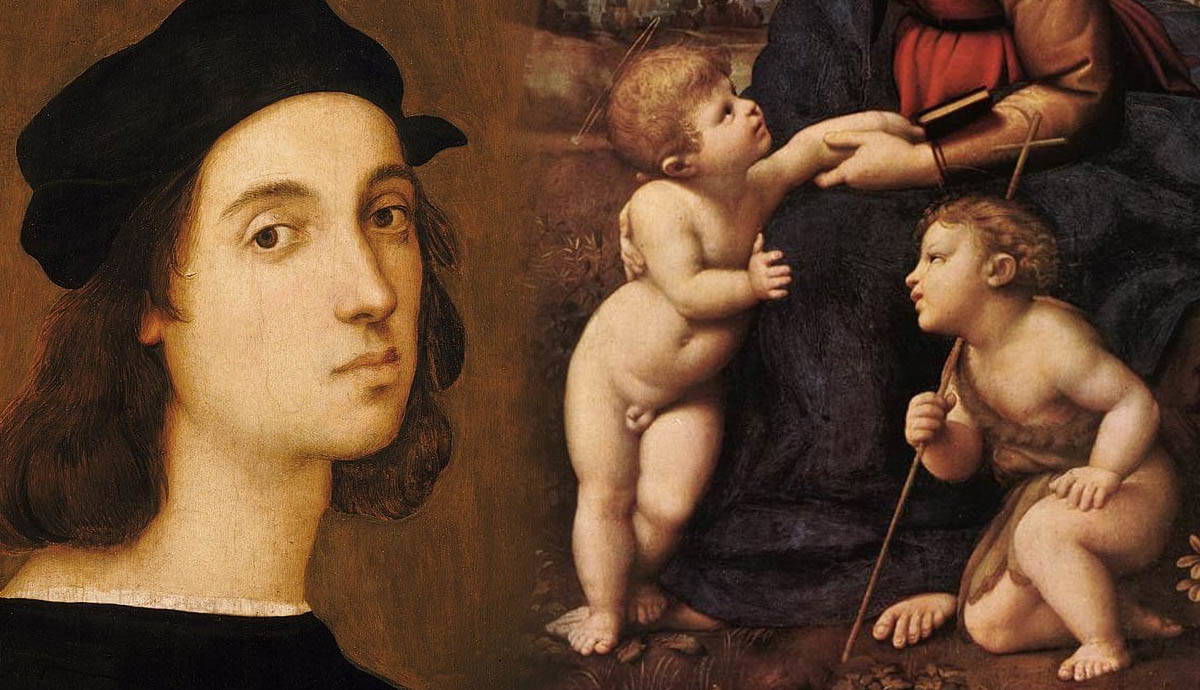
His work has been renowned for its delicacy and clarity in technique while achieving the grandiose themes of the Renaissance. His death at age 37 and in the peak of his career and a consequentially smaller body of work than his contemporaries, he is still recognized as one of the most important painters of his time. Below are some important points in his life and career.
Urbino’s Cultural Climate was an Early Influence

Raphael was born to a wealthy Urbino merchant family. His father, Giovanni Santi di Pietro was a painter for the Duke of Urbino, Federigo da Montefeltro. Although his father held this high-ranking position, he was regarded as a painter “of no great merit” by Giorgio Vasari.
However, Giovanni was very culturally adept, and through him, Raphael was exposed to and influenced by the modern, sophisticated cultural epicenter of Urbino. His father also arranged for him to study under known Italian Renaissance painter Pietro Perugino at age eight.
He Worked in Urbino, Florence, and Rome

After his father died, leaving him orphaned at age eleven, Raphael took over his studio in Urbino and was exposed to the humanistic mindset at the court. He was still working under Perugino at that time, graduating at the age of seventeen with the recognition of a master. In 1504, he moved to Siena and then to Florence, the buzzing epicenter of the Italian Renaissance.
During his time in Florence, Raphael produced numerous Madonna paintings and developed into artistic maturity. He remained in Florence for four years, cultivating his own recognizable style. He was then invited to work under Pope Julius II in Rome after being recommended by the architect of St. Peter’s Basilica in Rome, where he lived for the rest of his life.
Raphael, Michelangelo and Leonardo da Vinci were the fore-running painters of the Italian High Renaissance
While in Florence, Raphael met his lifelong rivals, fellow painters Leonardo da Vinci and Michelangelo. He was persuaded to diverge from his sophisticated style learned from Perugino to adopt the more emotive, ornamented style used by da Vinci. Da Vinci then became one of Raphael’s primary influences; Raphael studied his renderings of the human form, his use of the lush coloration known as chiaroscuro and sfumato, and his grandiose style. From this, he created a style of his own that utilized his delicate taught technique to create rich and decadent pieces.

Raphael and Michelangelo were bitter rivals, both being prominent Renaissance painters who worked in Florence and Rome. In Florence, Michelangelo accused Raphael of plagiarism after he produced a painting that resembled one of Michelangelo’s.
While the two painters both exhibited master skill in their works, due to Raphael’s friendly character and amiable disposition, he was preferred by many patrons, eventually exceeding Michelangelo in notoriety. However, because of his death in Rome at the age of 37, Raphael’s cultural influence was eventually surpassed by Michelangelo’s.
He was regarded as the most important painter in Rome during his lifetime

After his commission to paint in Rome by Pope Julius II, Raphael would continue to work in Rome for the next twelve years until his death in 1520. He worked for Pope Julius II’s successor, the son of Lorenzo de’ Medici Pope Leo X, earning him the title ‘Prince of the Painters’ and making him the primary painter in the Medici Court.
His commissions during this time included the Pope Julius II’s apartment in the Vatican, the fresco of Galatea in the Villa Farnesina in Rome and designing the interior of the church of St. Eligio degli Orefici in Rome with Bramante. In 1517, he was appointed the commissioner of antiquities of Rome, giving him full reign over the artistic projects in the city.

Raphael also held several architectural honors during this time. He was the Architectural Commissioner of the rebuild of St. Peter’s Basilica in Rome in 1514. He also worked on the Villa Madama, an abode of the later Pope Clement VII, the Chigi Chapel and the Palazzo Jacopo da Brescia.
He was sexually precocious and is said to have died from too much lovemaking
Although Raphael never married, he was known for his sexual exploits. He became engaged to Maria Bibbiena in 1514, but she died of illness before they wed. Raphael’s most famous love affair was with Margherita Luti, who was known as the love of his life. She was also one of his models and is rendered in his painting.

Raphael died on April 6, 1520, both his 37th birthday and Good Friday. While the actual cause of his death is not known, Giorgio Vasari states that he acquired a fever after a night of intense lovemaking with Margherita Luti.
He then claims that Raphael never disclosed the reason for his fever and was thus treated with the wrong medicine, which killed him. He had an extremely grand funeral and requested to be buried next to his late fiancée, Maria Bibbiena, in the Pantheon in Rome. At the time of his death, he was working on his final piece, Transfiguration, which was hung above his grave at his funeral procession.
Auctioned works by Raphael

Head of a Muse by Raphael
Price realized: GBP 29,161,250
Auction house: Christie’s, 2009
 Saint Benedict Receiving Maurus and Placidus by Raphael
Saint Benedict Receiving Maurus and Placidus by Raphael
Price realized: USD 1,202,500
Auction house: Christie’s, 2013
 The Madonna della Seggiola by Raphael
The Madonna della Seggiola by Raphael
Price realized: EUR 20,000
Auction house: Christie’s, 2012







